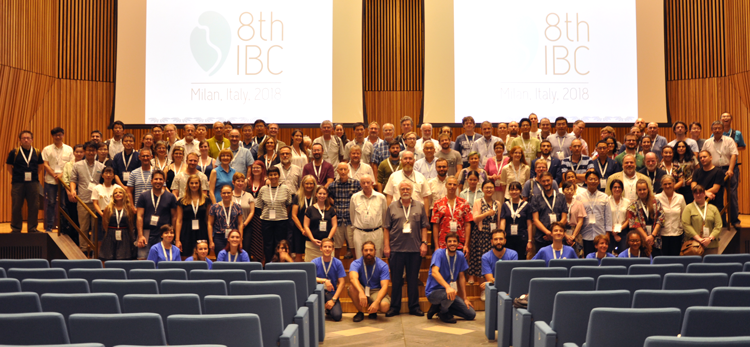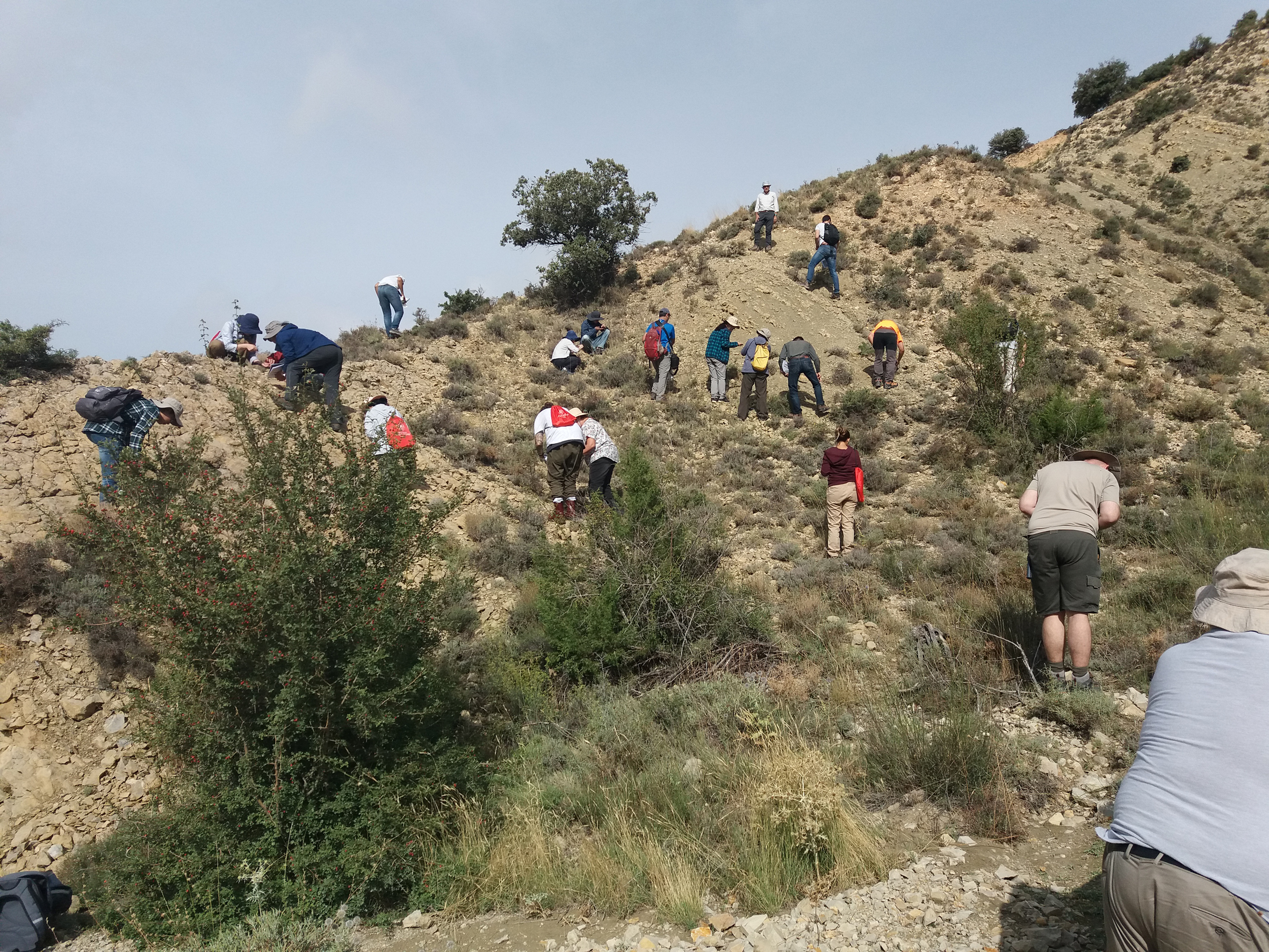|
International Brachiopod Congresses started in Brest in 1985 and were taking place every five years until the seventh session in Nanjing in 2015 (Halamski, 2016), during which a proposal of more frequent reunions (triennial instead of quinquennial) was voted. The eighth session was held at the University of Milan (Università degli Studi di Milano) and organised by a committee chaired by Lucia Angiolini from Milan and Renato Posenato from Ferrara. One hundred and fifty scientists from 23 countries registered for the congress, the most numerous delegation being that of Italy, the host country (31 delegates), closely followed by China (27 delegates). Other largely represented countries included Germany (16 delegates), the UK (11), the USA (9), Japan (7), Spain and Poland (both five delegates). Sweden, Russia, France, and Austria were represented by four delegates each; New Zealand, Argentina, Israel, and the Czech Republic by three; Canada, Hungary, Slovakia, and Iran by two; Belgium, Armenia, and Korea were represented by single delegates. Compared to the Nanjing congress, in Milan participants were much more numerous (150 vs. 104). This was due, among others, to the presence of many geochemists working on brachiopods who mostly had not been taking part in brachiopod congresses up to now. One may also note the presence of numerous Ph.D. students, unlike the previous sessions. Readers might be curious to know that this has been the first IBC during which abstracts were not printed, but distributed to delegates on USB sticks instead. Presentations were divided into plenary lectures (50 minutes), keynote lectures (25 minutes) and ordinary talks (15 minutes). The list of subjects selected by organisers for lectures may be a good survey of major present research topics. The three plenary lectures (one for each day of the congress), summarising the state of knowledge in research domains in which important advances have been made recently, were those by Holmer et al. (2018) on phylogeny of Cambrian brachiopods [cancelled as the author was prevented from coming at the last minute and replaced by very short presentations of selected abstracts by Ph.D. and M.Sc. students], by Brand (2018) on brachiopod geochemistry, and by E. Harper (2018) on recent brachiopods. There were eleven keynote lectures. Butler et al. (2018) compared fossil- and molecular-based reconstructions of biomineralisation in brachiopods. Stigall (2018) stressed that brachiopods are the animal group with the best fossil record and provided examples of taxonomic, evolutionary, and biogeographic questions studied using brachiopods. Temereva & Kuzmina (2018) discussed the lophophore evolution in brachiopods on the basis of studies of recent Pelagodiscus. Ziegler et al. (2018) presented a detailed physiological study of fibre formation in Magellania. Rollion-Bard et al. (2018) talked about geochemical proxies and biomineralisation in brachiopods. Both Vörös (2018) and Shen et al. (2018) investigated mass extinction phenomena in brachiopods, the former focussing on post-Palaeozoic cases and the latter on the Permian-Triassic extinction. Zhang et al. (2018) spoke about the Cambrian explosion and D. Harper (2018) about the Ordovician diversification in brachiopods. Twitchett (2018) summarised data on brachiopods in post-Permian hothouse worlds. Shiino (2018) studied evolutionary morphology of brachiopods. A subjective selection of talks of more general scope follows. Carlson et al. (2018) summarised recent progresses in elucidating the phylogeny of the terebratellidines, which are the most diverse group of extant brachiopods. Cocks & Torsvik (2018) discussed the usefulness of brachiopods for palaeogeographic reconstructions, illustrating the conclusions with images taken from their recent book on palaeogeography (Torsvik & Cocks, 2017). Madison & Kuzmina (2018) presented data on life cycles of Cambrian brachiopods. Skovsted et al. (2018) presented convincing evidence that, despite recent claims published in Nature (Moysiuk et al., 2017), hyoliths are not lophophorates. Topper & Harper (2018) dealt with the oldest brachiopods. Last but not least, one may note that climate change was present both as unpleasant reality – with temperatures over 30°C, significantly higher than mid-September average in Milan – and as a subject of posters by Jurikova et al. (2018) and Ye et al. (2018) dealing with brachiopod responses to ocean acidification. Chinese brachiopodologists brought with them copies of the monograph on „Phanerozoic brachiopod genera of China” (Rong, 2017), the publication of which had been announced during the Nanjing congress. This elegantly printed two-volume book containing descriptions and illustrations (125 plates) of almost all brachiopod genera, the type species of which come from China, summarises knowledge contained in many papers published not seldom solely in Chinese and often in local journals, so poorly known outside China. According to Rong (2017), out of 757 genera within 15 orders described from China, 452 are considered valid, 287 are junior synonyms, and 18 are removed from brachiopods. One can hardly imagine a palaeontological congress without a fieldtrip. Those proposed to the participants of the 8th IBC were particularly varied and included a four-day pre-congress fieldtrip to Spain (cf. infra), two one-day excursions to northern Italy on the mid-congress free day (Lower Pleistocene Arda River marine succession and Triassic in the Grigna Mts.), and two four-day post-congress fieldtrips, one to Sicily (Jurassic to Pleistocene) and another to England (cf. infra). The detailed guidebooks published for these fieldtrips (Angiolini et al., 2018; D’Arpa et al., 2018; García-Joral et al., 2018) will certainly remain valuable references for future students. I was able to take part in the Spanish and English excursions. The fieldtrip to Spain started on 6th September in Madrid, from where participants headed northwards to Aragon, where in the Iberian Ranges two days were devoted to the Jurassic and one to the Palaeozoic (Ordovician, Silurian, and Devonian). The last day took us far southwards, to the Betic Mountains near Alicante, where we admired the Liassic faunas of the Mediterranean province. In total we travelled for about 1000 km, being shown diverse, rich, and mostly well preserved brachiopod faunas. The fieldtrip to England was devoted to Palaeozoic brachiopods. The first two days focused on the Lower Carboniferous (Visean) succession in the Pennines, including spectacular assemblages of Gigantoproductus, the largest brachiopod that ever lived. In Ricklow Dale participants were informed about the very recent discovery of endosymbiosis that allowed these brachiopods to attain their extraordinary size (Angiolini et al., accepted). The subject of the other two days was the Ordovician–Silurian succession in Shropshire. It has been a pleasure to come to this well organised congress, the subjects of which were a successful combination of tradition and modernity, just as the modern air-conditioned lecture room, in which we sat, had been aptly placed within the splendid 15th century buildings of the University. Like for the previous session, the abstracts of talks and posters presented during the congress were published as a special issue of the Permophiles (Vol. 66, Suppl. 1; ISSN 1684-5927). The next session will take place in Berlin in 2021. References Angiolini L., Crippa G., Azmy K., Capitani G., Confalonieri G., Della Porta G., Griesshaber E., Harper D.A.T., Leng M.J., Nolan L., Orlandi M., Posenato R., Schmahl W.W., Banks V.J. & Stephenson M.H. The giants of the phylum Brachiopoda: a matter of diet? Palaeontology (accepted). Brand U., 2018. Modern and fossil brachiopods: superheroes of archives. Permophiles, 66 (Suppl. 1), 29–30. Butler A.D., Eitel M., Wörheide G., Carlson S.J. & Sperling E.A., 2018. Phylogenomic analysis of Brachiopoda: revealing the evolutionary history of biomineralization with an integrated palaeontological and molecular approach. Permophiles, 66 (Suppl. 1), 37. Carlson S.J., López Carranza N., Butler A.D. & Sperling E.A., 2018. Extant Terebratellidina phylogeny and homology of the long loop. Permophiles, 66 (Suppl. 1), 38–39. Cocks L.R.M. & Torsvik T.H., 2018. Useful and useless – brachiopods and palaeogeogeography. Permophiles, 66 (Suppl. 1), 44. D’Arpa C., Di Stefano P., Agate M., Di Patti C., Surdi G., Rosso A., Sanfilippo R., Vertino A., Ruggiero Taddei E. & Vörös A. (eds), 2018. 8th International Brachiopod Congress Field Guide. E4: Jurassic to Pleistocene brachiopod beds of Sicily (Italy), 48 pp. García-Joral F., Villas E. & Baeza-Carratalá J.F. (eds), 2018. 8th International Brachiopod Congress Field Guide. E1: Paleozoic and Mesozoic brachiopods of East Spain, ii + 76 pp. Workcenter Servicios Globales de Documentación, Madrid. Halamski A.T., 2016. Seventh International Brachiopod Congress Nanjing, China, 22–25 May 2015. http://paleopolis.rediris.es/BrachNet/REF/Pub/halamski-2016.html. Harper D.A.T., 2018. The rise of the rhynchonelliform brachiopods: the role of the great Ordovician biodiversification event. Permophiles, 66 (Suppl. 1), 55. Harper E.M., 2018. Living brachiopods: hanging on or fit for a modern world? Permophiles, 66 (Suppl. 1), 55–56. Holmer L.E., Zhang Z., Zhang Z., Brock G.A. & Popov L.E., 2018. Brachiopod phylogeny in the Cambrian. Permophiles, 66 (Suppl. 1), 56–57. Jurikova H., Liebetrau V., Gutjahr M., Rollion-Bard C., Hu M.Y., Krause S., Henkel D., Hiebenthal C., Schmidt M., Laudien J. & Eisenhauer A., 2018. Geochemical and physiological responses of brachiopods to ocean acidification – new insights from boron isotopes. Permophiles, 66 (Suppl. 1), 62–63. Madison A. & Kuzmina T., 2018. Fossil records of the evolution of brachiopod life cycles. Permophiles, 66 (Suppl. 1), 75–76. Moysiuk J., Smith M.R. & Caron J.B., 2017 Hyoliths are Palaeozoic lophophorates. Nature 541, 394–397. Rollion-Bard C., Milner Garcia S., Saulnier S., Burckel P., Vigier N., Angiolini L., Tomašových A., Henkel D., Jurikova H. & Lécuyer C., 2018. What can geochemical proxies tell about the biomineralization processes of brachiopods? Permophiles, 66 (Suppl. 1), 92–93. Rong Jiayu (ed.), 2017. Phanerozoic brachiopod genera of China. Science Press, Beijing, 2 vols. xviii + 1096 pp. Shen S., Ramezani J., Chen J., Cao C., Erwin D.H., Zhang H., Xiang L., Schoepfer S.D., Henderson C.M., Zheng Q., Bowring S.A., Wang Y., Li X., Wang X., Yuan D., Zhang Y., Mu L., Wang J. & Wu Y., 2018. A sudden end-Permian mass extinction in South China. Permophiles, 66 (Suppl. 1), 95–96. Shiino Y., 2018. Form and function of fossil brachiopods: insights into evolutionary morphology. Permophiles, 66 (Suppl. 1), 96–97. Skovsted C.B., Liu F., Topper T.P., Zhang Z. & Shu D., 2018. Are hyoliths brachiopods? Permophiles, 66 (Suppl. 1), 103–104. Stigall A.L., 2018. Brachiopods as key to evolutionary theory: from foundational systematics and phylogenetics to speciation and biogeography. Permophiles, 66 (Suppl. 1), 108–109. Temereva E. & Kuzmina T., 2018. Organization of the lophophore in linguliform Pelagodiscus atlanticus (King) and the evolution of the lophophore in brachiopods. Permophiles, 66 (Suppl. 1), 111–113. Topper T.P. & Harper D.A.T., 2018. Back to the beginning: the life and times of Cambrian brachiopods. Permophiles, 66 (Suppl. 1), 115–116. Torsvik T.H. & Cocks L.R.M., 2017. Earth History and Palaeogeography. Cambridge University Press, 332 pp. Twitchett R.J., 2018. Brachiopods in post-Permian hothouse worlds. Permophiles, 66 (Suppl. 1), 116–117. Vörös A., 2018. Mass extinctions and fatal extinctions in the history of brachiopods: review and post-Paleozoic cases. Permophiles, 66 (Suppl. 1), 118–119. Ye F., Jurikova H., Angiolini L., Brand U., Crippa G., Henkel D., Laudien J., Hiebenthal C. & Šmajgl D., 2018. Variation in brachiopod microstructure and isotope geochemistry under low pH – ocean acidification – conditions. Permophiles, 66 (Suppl. 1), 126. Zhang Z., Holmer L.E., Brock G.A. & Topper T.P., 2018. Paleoecological complexities during Cambrian explosion: evidence from brachiopods. Permophiles, 66 (Suppl. 1), 131–132. Ziegler A., Simonet-Roda M., Griesshaber E., Henkel D., Häusermann V., Eisenhauer A., Laudin J. & Schmahl W.W., 2018. Mechanisms of calcite fibre formation in Magellania venosa. Permophiles, 66 (Suppl. 1), 137–138. |
|
Some 8thIBC photographs
[1] Fieldtrip to Spain, 7th September, 2018. Palaeontologists examining the Ordovician rocks of the La Peña del Tormo section in the Iberian Range. Photo by A. Baliński.
[2] Fieldtrip to Spain, 8th September, 2018. Rambla del Salto section in the Aragonese Branch of the Iberian Range near Teruel. [2a] General view of the gorge. Photo by A. Baliński. [2b] Congress delegates on the Toarcian part of the section. Photo provided by F. García-Joral. [3] Fieldtrip to Spain, 9th September, 2018. José Enrique Tent-Manclús explaining the geology of the Betic Mountains. Liassic, Cerro de la Cruz section, Reclot Mountain Range near Alicante. Photo by A.T. Halamski. [4] Congress proceedings, 12th September, 2018. Courtyard of the University of Milan with tables prepared for lunch for the congress delegates. Photo by A.T. Halamski. [5] Congress proceedings, 12th September, 2018. A discussion during the session. Left to right: Attila Vörös, Shuzhong Shen, Andrzej Baliński, and Fernando García-Joral. Photo by A.T. Halamski.
[6] Congress proceedings, 12th September, 2018. Brachiopod model built by the preparator Rolf Spitz under the supervision of Ulrich Jansen (both Senckenberg, Frankfurt am Main). The model had been on display in a small wandering exhibition accompanying the BASELiNE Project and now is planned to be integrated into the permanent exhibition at the Senckenberg. [6a] Close-up of the model. [6b] Daniela Henkel (GEOMAR, Kiel), manager of the BASE-LiNE Earth Project, holding the model. Photos by A.T. Halamski. [7] Fieldtrip to England, 15th September, 2018. The Pennine Mountains, Curbar Edge: flat-lying Namurian sandstones (Millstone Grit) on the right, low hills on the left corresponding to Visean limestone. Photo by A.T. Halamski. [8] Fieldtrip to England, 16th September, 2018. The Pennine Mountains, on the way to Ricklow Dale. Andrzej Baliński crossing a stone wall enclosing a pasture. Photo by A.T. Halamski. [9] Fieldtrip to England, 16th September, 2018. Rain on the Visean outcrops in Ricklow Dale. Lucia Angiolini explaining, Mike Stephenson holding the umbrella. Photo by A.T. Halamski. [10] Fieldtrip to England, 16th September, 2018. Vanessa Banks and Mike Stephenson explaining the geology of the Pennines. Photo by A.T. Halamski. [11] Fieldtrip to England, 17th September, 2018. Palaeontologists returning from the Ordovician section in the Onny valley (Shrophire). Photo by A.T. Halamski. [12] Fieldtrip to England, 17th September, 2018. Ordovician brachiopods Dinorthis, Harknessella, and Heterorthis. Outcrop of the so-called Harknessella beds (Coston beds) at Upper Coston Farm; Costonian, lowest Caradoc. Photo by A. Baliński. [13] Fieldtrip to England, 18th September, 2018. The Severn in Ironbridge. Photo by A. Baliński. [14] Fieldtrip to England, 18th September, 2018. D.A.T. Harper and L. Angiolini discussing over Silurian rocks in Benthal Edge Wood (Shropshire). Photo by A. Baliński. |


